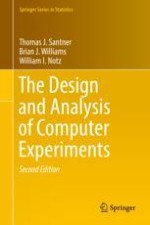2018 | OriginalPaper | Buchkapitel
5. Space-Filling Designs for Computer Experiments
verfasst von : Thomas J. Santner, Brian J. Williams, William I. Notz
Erschienen in: The Design and Analysis of Computer Experiments
Verlag: Springer New York
Aktivieren Sie unsere intelligente Suche, um passende Fachinhalte oder Patente zu finden.
Wählen Sie Textabschnitte aus um mit Künstlicher Intelligenz passenden Patente zu finden. powered by
Markieren Sie Textabschnitte, um KI-gestützt weitere passende Inhalte zu finden. powered by
